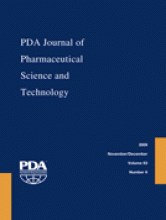Abstract
Nefopam hydrochloride, a nonsteroidal anti-inflammatory drug, is administered in tablet form three times daily or as intramuscular injection at 6-h intervals to treat disorders such as acute or constant pain. It is also used for a prolonged treatment of severe pain, when morphine therapy has to be withdrawn for morphine-related dependence. To achieve a constant drug–plasma level of nefopam for a prolonged period, a transdermal drug delivery system was fabricated in our present study by employing suitable experimental hydrophilic and lipophilic polymeric combinations of polyvinyl pyrrolidone (PVP) and ethyl cellulose (EC). Physical studies including weight variation, moisture content, moisture uptake, flatness, external morphology of the formulations, and in vitro drug release were performed. Drug–excipient interaction studies were carried out using Fourier transform infrared spectroscopy. In vitro skin permeation study with cadaver skin was conducted using modified Keshary-Chein diffusion cells. Interactions between nefopam and PVP seem to contribute to the slow and controlled release pattern of nefopam. The scanning electron microscopy evaluation of prepared matrix patches revealed that drug was dispersed uniformly in polymeric matrix. In vitro drug release study showed that an increase in concentration of hydrophilic polymer, PVP, enhanced drug release substantially. In vitro skin permeation study showed variable permeation profiles of nefopam from the experimental patches. Among the formulations, PVP:EC (1:3) was found to provide slowest release and maximum sustained skin permeation of drug in vitro. Application of those patches, PVP:EC (1:3), on human volunteers was found to provide systemic availability of the drug till 48 h.
- Nefopam
- Formulation
- Transdermal drug delivery
- In vitro and in vivo skin permeation studies
- Controlled release
- FTIR
- Scanning electron microscopy
- HPLC
- © PDA, Inc. 2009
PDA members receive access to all articles published in the current year and previous volume year. Institutional subscribers received access to all content. Log in below to receive access to this article if you are either of these.
If you are neither or you are a PDA member trying to access an article outside of your membership license, then you must purchase access to this article (below). If you do not have a username or password for JPST, you will be required to create an account prior to purchasing.
Full issue PDFs are for PDA members only.
Note to pda.org users
The PDA and PDA bookstore websites (www.pda.org and www.pda.org/bookstore) are separate websites from the PDA JPST website. When you first join PDA, your initial UserID and Password are sent to HighWirePress to create your PDA JPST account. Subsequent UserrID and Password changes required at the PDA websites will not pass on to PDA JPST and vice versa. If you forget your PDA JPST UserID and/or Password, you can request help to retrieve UserID and reset Password below.






